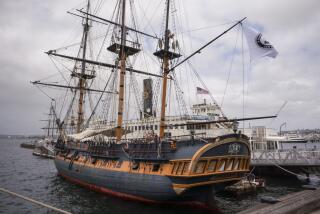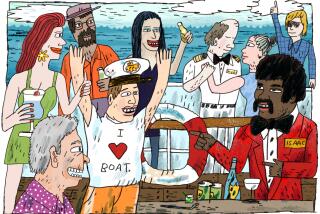A luxurious putter around Britain aboard the Patricia
SWANSEA, Wales — The Patricia is a small, hardworking ship that putters around the coast of England and Wales, tending buoys and lighthouses. At 283 feet long, it’s about a quarter the length of Cunard’s vaunted Queen Mary 2 ocean liner.
And yet the Patricia is even more properly British and perhaps even more luxurious, having as it does six handsomely furnished, spacious passenger cabins on its upper decks — one of which once was Prince Philip’s cabin of choice. And now it would be ours.
My wife, Laurel, and I met our seven fellow passengers at King’s Dock in the port of Swansea on a September afternoon. Stewards Chrissy and Adam led us to the unprepossessing ship, properly called THV (Trinity House Vessel) Patricia, dominated by two gangly masts and a wide, rust-scarred work deck.
The Corporation of Trinity House, which has been around for 500 years (May 20 is the anniversary), has three functions. It’s a maritime charity, it provides pilots to guide ships into harbors and it serves as a general lighthouse authority for England, Wales and the Channel Islands, the function that involves the Patricia.
For a week, we luxuriated in Patricia’s Stateroom 1, which Prince Philip liked when he was master of Trinity House. (Anne, the Princess Royal, took over recently from her father and prefers Stateroom 2.)
The creation of Patricia Voyages in 2003 allows the public to book passage and enjoy rooms and services originally intended for the Trinity House visiting committee, which periodically comes aboard to check things out as the Patricia makes its rounds.
After Britain’s last manned lighthouses were automated in 1998, inspections dwindled (the committee sailed for only three weeks in 2013) and that opened up excess capacity for the likes of us. We could tag along and watch whatever work was at hand. Advance information made it clear that there was no guarantee what it would be or where we would be sailing.
We climbed the gangway to the passenger quarters and found Stateroom 1— almost absurdly roomy, with desk, bureau, sofa, easy chair, coffee table, double bed and windows looking out on the deck. Chrissy came by as we were settling in, and we introduced ourselves as Laurel and Karl.
“Hello, Laurel and Karl,” she said, “but from now on you’ll be Mr. and Mrs. Zimmermann. It’s company policy.” This nicely defined the Patricia: formal but friendly. We would be welcomed in the wheel house, for instance, except during close maneuvering, and given an extensive tour of the engine room.
We were soon on deck for the expected 4:30 p.m. sailing. Some lines were loosed; the crewmen on the dock waited, then sat down and eventually came back aboard. Something was amiss. Dave Cooper, our young captain, confirmed that there were problems with the starboard propulsion. Repairs were underway, a replacement circuit breaker might be sent for, perhaps departure on the morning tide.
The Welcome on Board dinner on the brightly polished table in the Elder Brethren Dining Room (named for the senior members of Trinity House) was considerable compensation for the delayed sailing: king prawns, rack of lamb, a tantalizing chocolate dessert with strawberry coulis, a cheese board. Meals were set, though substitutions were cheerfully accommodated by Andy, the cook, who had worked for Trinity House for 11 years and on the Queen Elizabeth 2 before that and was manager of passenger services.
There were place cards at dinner, and we were shuffled into different seating arrangements each night for sociability. At breakfast and lunch, our silver napkin rings were lined up for us to take to the seats of our choice. Lunch started with soup; a buffet of hot or cold meats and salads followed. Meals were at a set time, and we all ate together.
Breakfasts were classically British: eggs, sausage, bacon, blood pudding, potatoes, beans, tomato, kippers and, for the less ambitious, yogurt, fruit, cereals and juices on the sideboard, with toast racks and many varieties of marmalade on the table. Also on the table each morning was a “workplan” listing the day’s tasks and offering background on our current location.
“The plan today is somewhat yet unknown,” the workplan read the first morning, citing an “unexpected issue with the propulsion.” In fact, we didn’t sail until the next day — a disappointment — but Trinity House did have alternative plans for us.
That morning, Cooper took us on a tour through the Swansea yard, showing us the facilities for cleaning, restoring and repainting buoys and explaining their various types and functions. In the afternoon, we journeyed to the soaring Nash Point Lighthouse, about an hour’s taxi ride from Swansea. It was opened for us to tour, and the foghorn, now used only ceremonially, was sounded.
“You’ll be joining us in the ward room for cocktails tonight,” an officer said as we reboarded. “You’ll get a formal invitation from the ‘Old Man.’”
“The Old Man who’s really a young man,” I said. Though Cooper is in his 30s, a captain is always the Old Man.
The next morning, bright and breezy, we were on the monkey deck above the bridge as the Patricia sailed through the locks that control the King’s and Queen’s Docks. Our initial task, surveying a recently sunk fishing boat in Christchurch Bay, off the Isle of Wight, was scheduled for the following day, so we had some spare time, which allowed a detour to Lundy Island in the Bristol Channel.
Those of us willing to undertake a long climb up the ladder from work boat to wharf took a strenuous but scenic ramble on this remote, unspoiled National Trust property.
The next day, the work boat was down again to make a sonar survey of the wreck in Christchurch Bay; it was too deep to be a navigation hazard so there was no need to place a wreck buoy. In fact, the Patricia did no buoy work, its usual stock in trade, on our trip. But the following day, we had an unusual task in the Channel Islands just off France.
After spending the night anchored near Alderney, we steamed the few miles to Les Casquets, rocky islands with a lighthouse being converted to solar power. There we rendezvoused with a helicopter, which swooped back and forth from our helideck to the lighthouse with water and other supplies for the crew working there. Delighted, we watched the process through the broad windows of the lounge.
Then, too soon, the Patricia headed for the Solent and Southampton, England, journey’s end.
“Sometimes I have to pinch myself,” Chrissy had said one afternoon, gesturing toward those lounge windows and their sea and island views. “It’s the best job ever.” We had to disembark, while she, Adam and Andy prepared to receive our replacements. I wished we could stay.
More to Read
Sign up for The Wild
We’ll help you find the best places to hike, bike and run, as well as the perfect silent spots for meditation and yoga.
You may occasionally receive promotional content from the Los Angeles Times.






